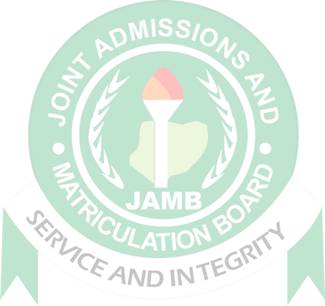
Mathematics (Core)
Paper 1 | Objectives | 51 Questions
JAMB Exam
Year: 1979
Level: SHS
Time:
Type: Question Paper
Answers provided
FREE
No description provided
Feedbacks
This paper is yet to be rated

Paper 1 | Objectives | 51 Questions
JAMB Exam
Year: 1979
Level: SHS
Time:
Type: Question Paper
Answers provided
No description provided
This paper is yet to be rated
Revision tips on test preparation for Grade A students to. Grade A students tips for any test.
Apply tips for stress-free eating before and during exams and what to avoid for good grades.
Make sure you study hard but not into the late-night hours to give your body the enough rest you need.
| # | Question | Ans |
|---|---|---|
| 1. |
The mean of the numbers 1.2, 1.0, 0.9, 1.4, 0.8, 0.8, 1.2 and 1.1 is A. 1.5 B. 0.8 C. 1.0 D. 1.02 E. 1.05
Show Content
Detailed Solution\(\frac{1.2 + 1.0 + 0.9 + 1.4 + 0.8 + 0.8 + 1.2}{8}\) = \(\frac{8.4}{8}\)= 1.05 |
|
| 2. |
\((1.28 \times 10^{4}) \div (6.4 \times 10^{2})\) equals A. 2 x 10-5 B. 2 x 10-1 C. 2 x 101 D. 2 x 10-4
Show Content
Detailed Solution\((1.28 \times 10^{4}) \div (6.4 \times 10^{2})\)= \(\frac{1.28 \times 10^{4}}{6.4 \times 10^{2}}\) \(\equiv \frac{12.8 \times 10^{3}}{6.4 \times 10^{2}}\) = \(2 \times 10^{1}\) |
|
| 3. |
If the value of \(\pi\) is taken to be \(\frac{22}{7}\), the area of a semi-circle of diameter 42m is A. 5544m2 B. 1386m2 C. 132m2 D. 264m2 E. 693m2
Show Content
Detailed Solution\(\pi\) = \(\frac{22}{7}\), Diameter D = 42mArea of a circle = \(\frac{\pi D^2}{4}\) when a diameter is given area of a semicircle \(\frac{\pi D^2}{4}\) x \(\frac{1}{2}\) = \(\frac{22}{7}\) x \(\frac{4262}{4}\) x \(\frac{1}{2}\) = \(\frac{11}{7} \times 441\) = 693m\(^{2}\) |
|
| 4. |
(3.2)2 - (1.8)2 equals A. 7.0 B. 2.56 C. 13.48 D. 2.0 E. 0.07
Show Content
Detailed Solution(3.2)2 - (1.8)2 = (3.2 + 1.8)(3.2 - 1.8)= 5 x 1.4 = 7 |
|
| 5. |
In \(\bigtriangleup\)PQR, PQ = 10cm, QR = 8cm and RP = 6cm, the perpendicular RS is drawn from R to PQ. Find the length of RS A. 4cm B. 32cm C. \(\frac{30}{7}\) D. \(\frac{40}{7}\) E. 4.8cm
Show Content
Detailed SolutionCos Q = \(\frac{r^2 + p^2 - q^2}{2rp}\)= \(\frac{10^2 + 8^2 - 6^2}{2(10)(8)}\) = \(\frac{164 - 36}{160}\) = \(\frac{128}{160}\) = 0.8 Q = Cos-1 o.8 = 37o x rep. from rt< RSQ, Let RS = x \(\frac{x}{sin 37^o}\) = \(\frac{8}{sin 90^o}\) but sin 90o = 1 x = 8 sin 37o x = 4.8cm |
|
| 6. |
After getting a rise of 15%, a man's new monthly salary is N345. How much per month did he earn before the increase? A. N330 B. N396.75 C. N300 D. N293.25 E. N360
Show Content
Detailed SolutionLet x represent his monthly salary before increase 15% ofx = 345 % profit = (100 + 15)% = 115% \(\frac{115}{100}\)x = 345 115x = 34500 x = N300.00 |
|
| 7. |
In base ten, the number 101101 (base 2) equals A. 15 B. 4 C. 45 D. 32 E. 90
Show Content
Detailed Solution(101101)2 \(\begin{array}{c|c} 2^5 & 2^4 & 2^3 & 2^2 & 2^1 & 2^o\\ \hline 1 & 0 & 1 & 1 & 0 & 1\end{array}\)= 1 x 25 + 0 x 24 + 1 x 23 + 1 x 22 + 0 x 21 + 1 x 2o = 32 + 0 + 8 + 4 + 0 + 1 = (45)10 |
|
| 8. |
The annul profits of a transport business were divided between the partners A and B in the ratio 3 : 5. If B received N3000 more than A, the total profit was A. N5000 B. N1800 C. N12000 D. N24000 E. N8000
Show Content
Detailed SolutionA : B = 3 : 5Total ratio = 3 + 5 = 8 Let rept, the total profit, A receives \(\frac{3x}{8}\) \(\frac{5x}{8}\) - \(\frac{3}{x}\) = 3000 \(\frac{5x}{8}\) - \(\frac{3x}{8}\) = 3000 = \(\frac{2x}{8}\) = 3000 2x = 2400 x = 1200 N12,000 |
|
| 9. |
X is directly proportional to y and inversely proportional to z. If x = 9 when y = 24 and z = 8, what is the value of x when y = 5 and z = 6? A. \(\frac{5}{6}\) B. 11 C. 3\(\frac{3}{5}\) D. 2\(\frac{1}{2}\) E. 1\(\frac{1}{5}\)
Show Content
Detailed Solutionx \(\alpha\) y = x \(\alpha\) \(\frac{1}{z}\)x \(\alpha\) \(\frac{1}{z}\) x = k \(\frac{y}{z}\) k = \(\frac{xz}{y}\) = \(\frac{9 \times 8}{24}\) = 3 x = \(\frac{xz}{y}\) = \(\frac{3 \times 5}{6}\) = \(\frac{15}{6}\) = \(\frac{5}{2}\) = 2\(\frac{1}{2}\) |
|
| 10. |
The solution of the equation x2 - 2x = 8 is A. x = 0 or 2 B. x = -2 or 4 C. x = 2 D. x = -4 E. x = 2 or 4
Show Content
Detailed Solutionx2 - 2x = 8 = 8x2 - 2x - 8 = 0 (x2 - 4x) + (2x - 8) = 0 When x + 2 = 0 x = -2, when x - 4 = 0 x = 4 -2 or 4 |
|
| 11. |
A trader goes to Ghana for y days with y cedis. For the first x days, he spends X cedis per day. The amount he has to spend per day for the rest of his stay is A. \(\frac{y(y - x)}{y - x}\) cedis B. \(\frac{Yy - Xx)}{y - x}\) cedis C. \(\frac{Y - Xy)}{y - x}\) cedis D. \(\frac{Y - X}{y - x}\) cedis E. \(\frac{Y - Xx}{y - x}\) cedis
Show Content
Detailed SolutionThe amount he has to spend per day for the rest of his stay is \(\frac{Y - Xx}{y - x}\) cedis |
Preview displays only 11 out of the 51 Questions